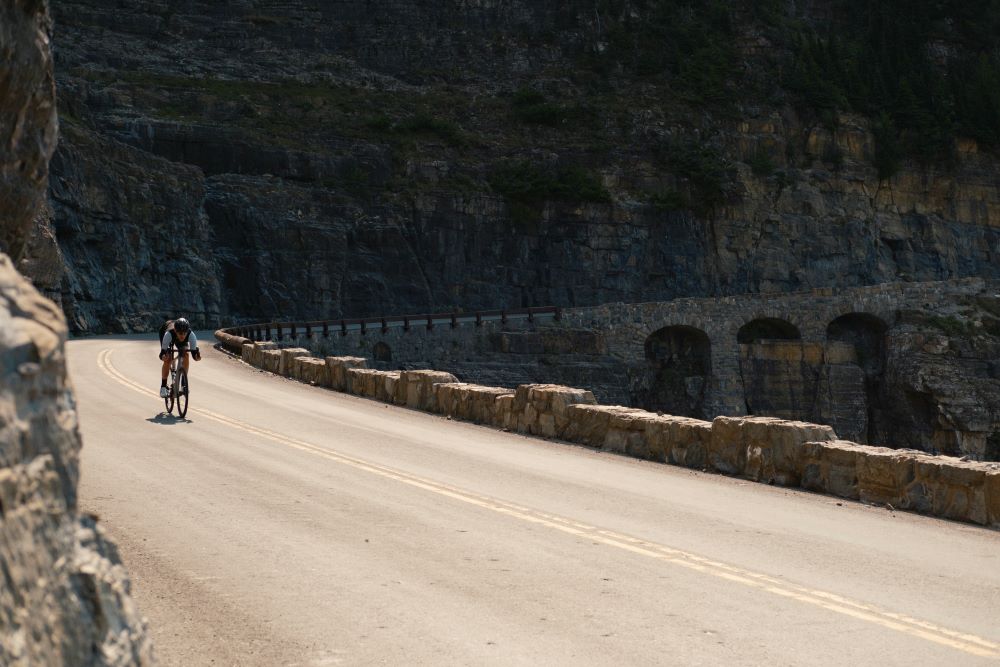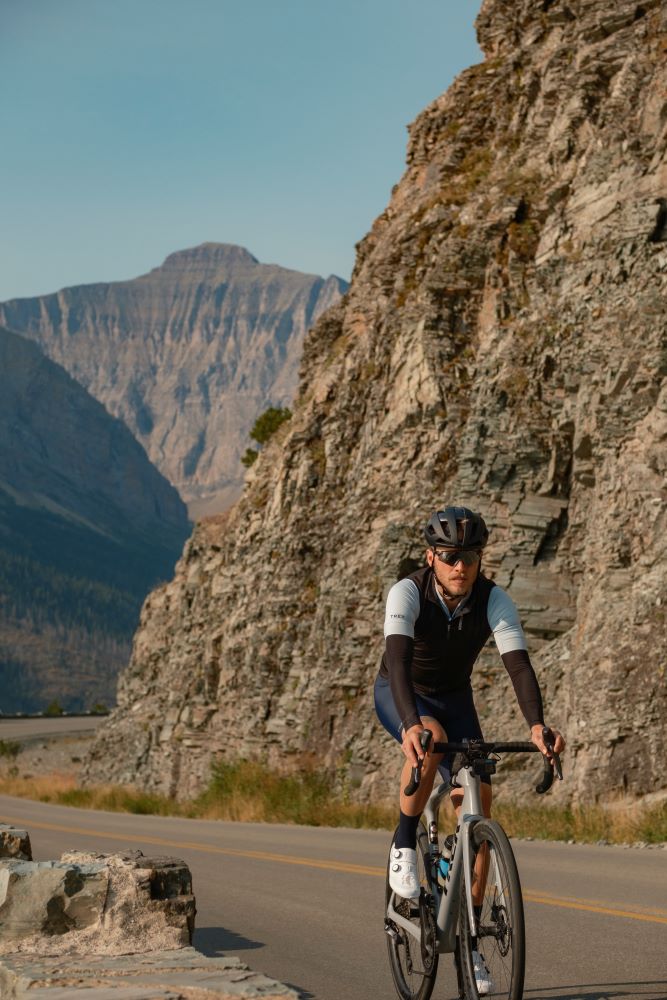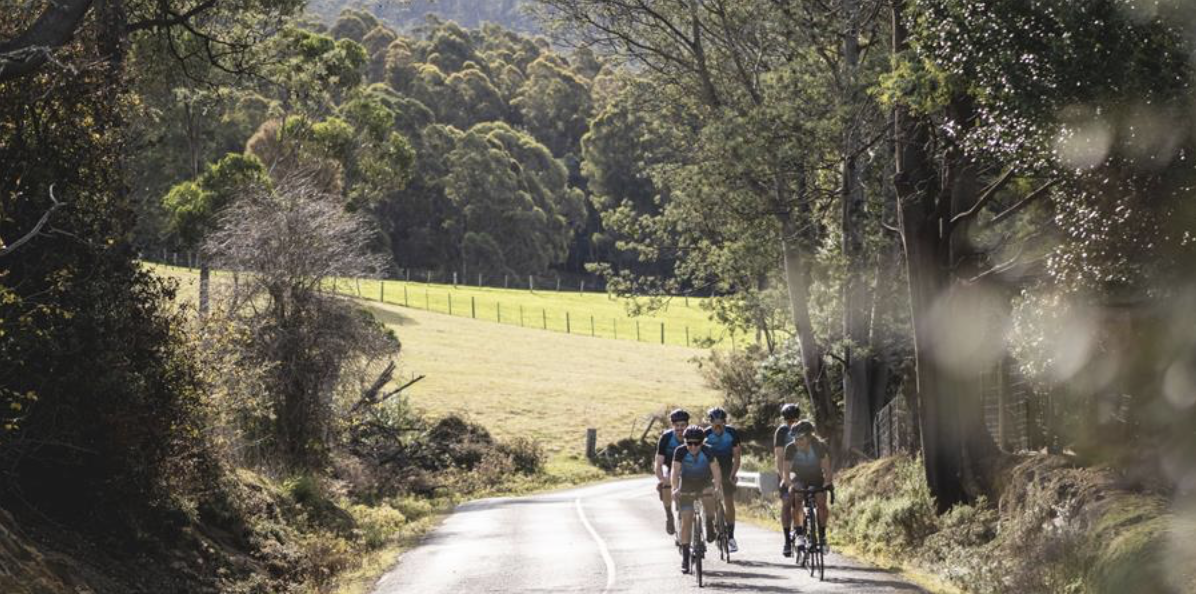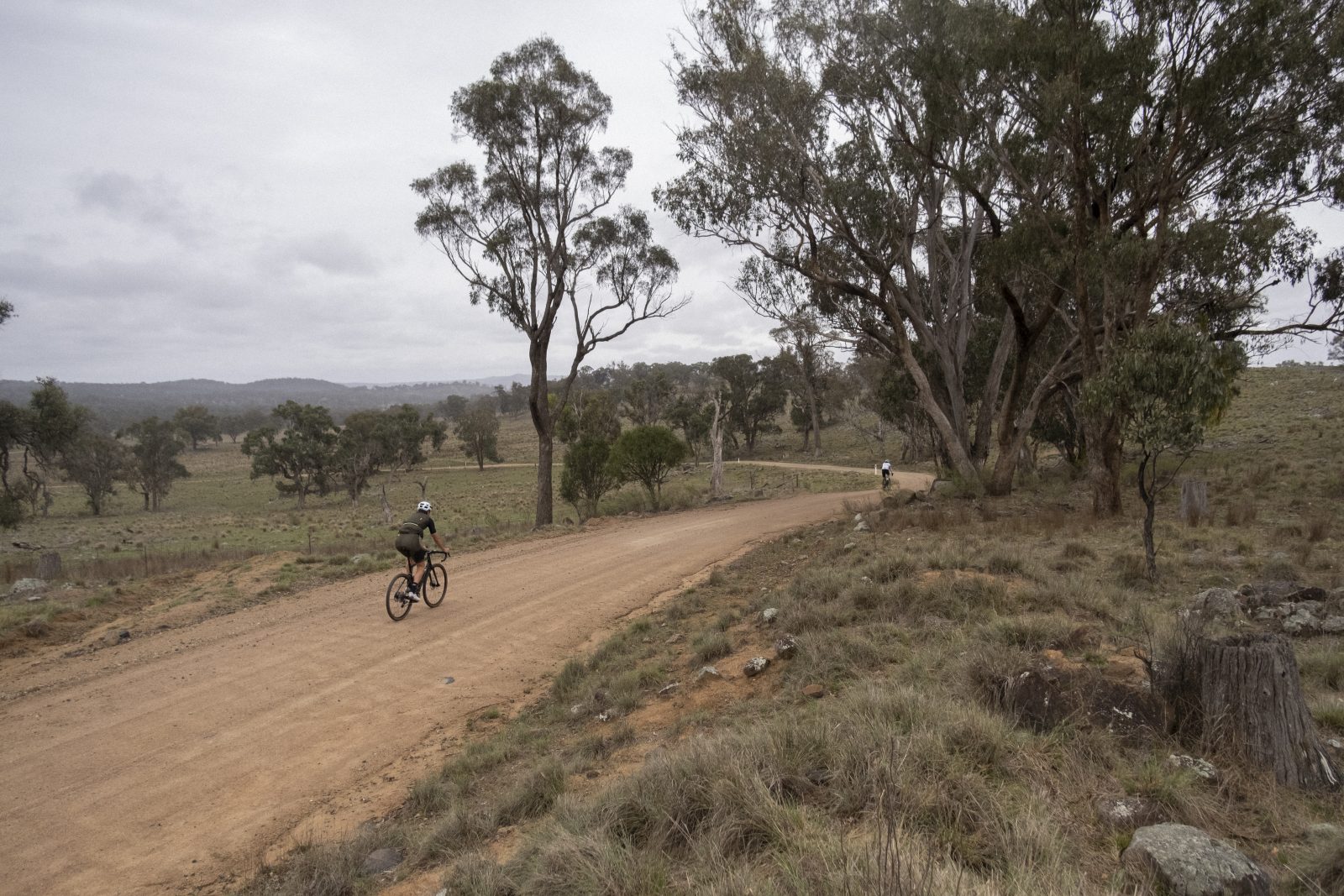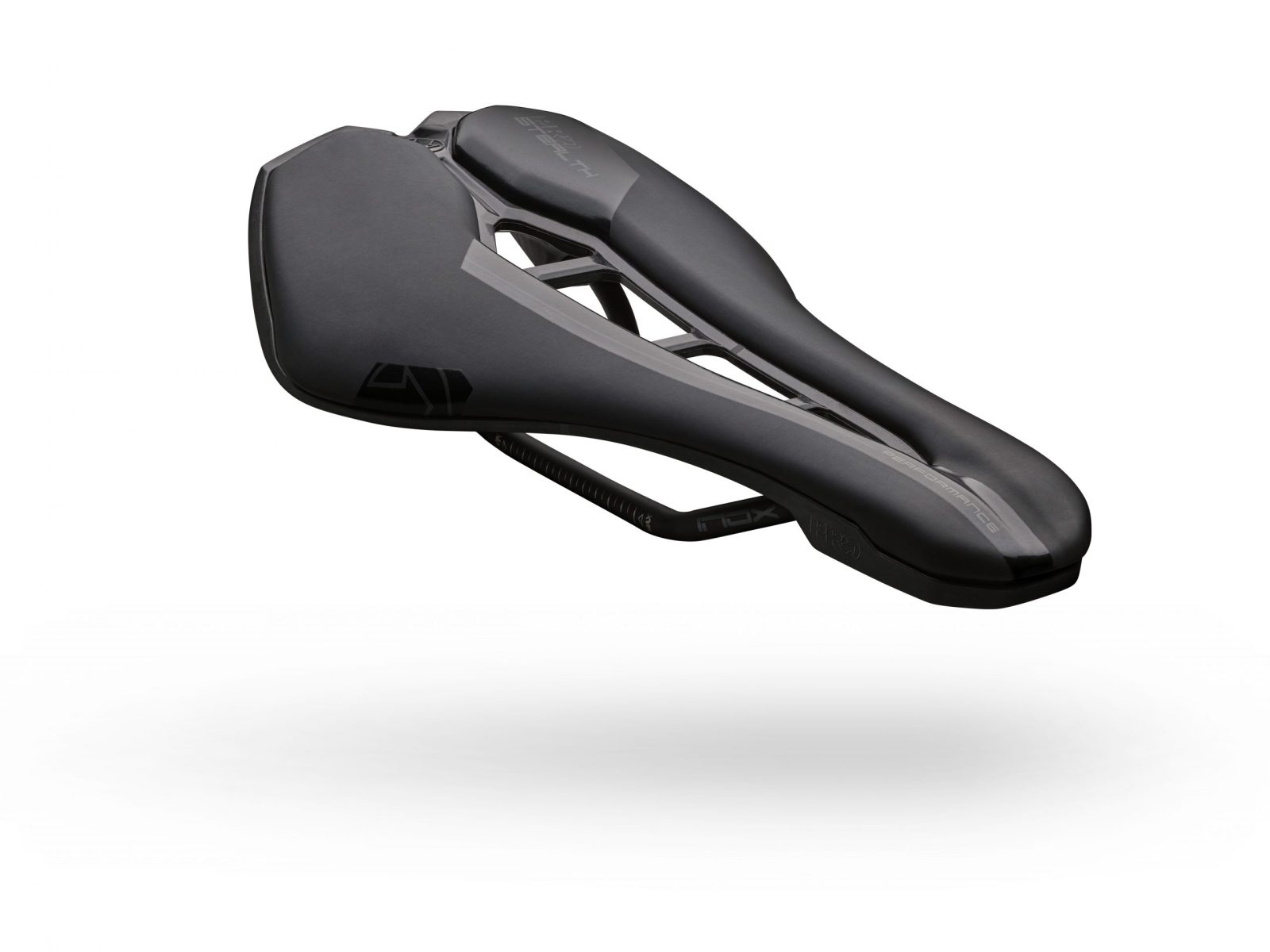Pristine wilderness, turquoise glacial lakes and climbs for days – including the breathtaking Going-to-the-Sun Road.
It doesn’t take long to see why people from the US state of Montana call their home ‘The Last Best Place’ on earth. Cyclist discovers for itself on an unforgettable five-day adventure in Glacier National Park with Trek Travel
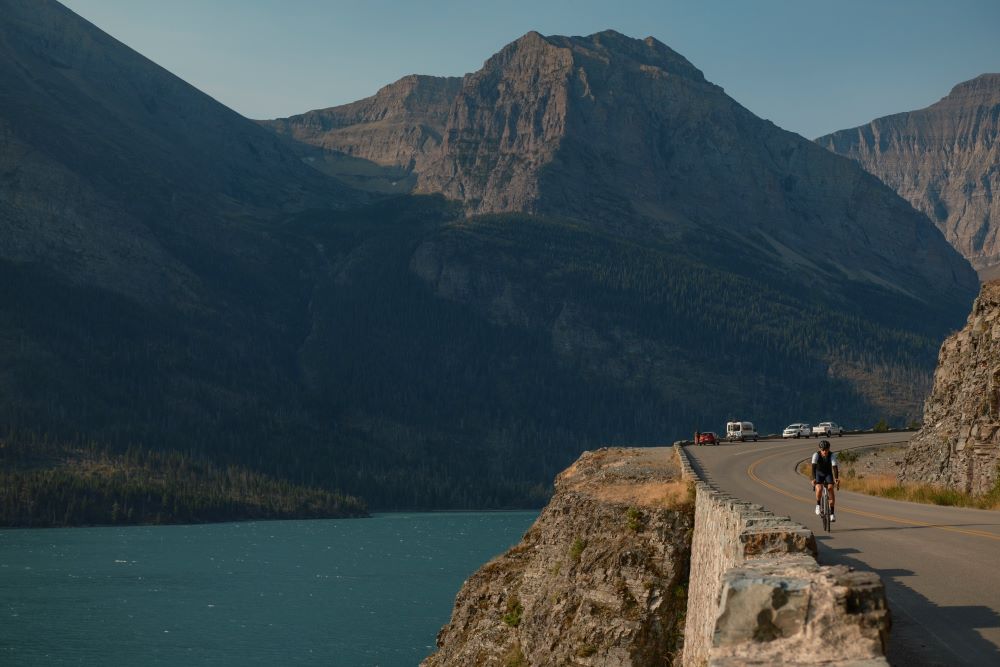
Words TAM ALLENBY Photography SIMON ESJAY JAMES
The ‘World’s Best Road’ competition doesn’t exist, but if it did, I’d be throwing Going-to- the-Sun Road into the mix.
It’s midmorning and I’m on two wheels in Glacier National Park, Montana.
The road surface is ribbon-smooth, the weather conditions are bluebird, and there’s no way to describe the scene in front of me without resorting to cliché.
It’s gobsmacking. To my left, Saint Mary Lake, turquoise and shimmering in the early morning sun; to my right, a sheer, crumbling cliff face; and in front of me, imposing limestone peaks completely dominating the horizon.
I’d love to tell you that I just rolled along, soaking it all in, but it’s 2023, so I reach for my phone to post a story to Instagram.
I’m far from the first person to capture the view: in fact, Oscar winner Stanley Kubrick made use of this exact spot to film the opening credits to The Shining (1:09 in this clip for those playing at home: (youtu.be/9spGH0YMkj8).
But apart from our remote mountain lodgings the night before, the vibes this morning are about as far from a horror movie as it’s possible to be.
It’s pure riding bliss. Three hours later – and with both sides of the majestic Logan Pass (and Going-to-the-Sun Road, which dissects Glacier NP) conquered – you couldn’t wipe the smile off my face if you tried.
And the award for ‘World’s Best Road’ goes to…
Mountain mode
Esjay and I are a little worried when we touch down in Kalispell, Montana, a few days earlier.
Wildfires across broad swathes of Northern USA and Canada have the two of us thinking back on the dark days of early 2020 back home in Sydney, and from the plane window at least, the famous mountains of the Big Sky State are barely visible through the smoke.
We’re here courtesy of Trek Travel, who run all-inclusive cycling tours to some of the world’s top cycling destinations, and after a short transfer from the airport, a pleasant afternoon relaxing by the lake, and a somewhat jet lagged night’s rest in the ski town of Whitefish, wake bright and early on the first morning of our trip to meet our guides (Kyle and Eric) and fellow riders (a family of three from Maryland, and a couple from Colorado) on the six-day adventure.

Thankfully the weather gods have smiled on us and blown most of the smoke to the west, and after a two-and-a-half hour shuttle to Two Medicine Lake on the other side of Glacier National Park, we’re treated to the first of many jaw-dropping views of this vast, pristine ecosystem.
Encompassing more than a million acres, 1,100km of hiking trails, 762 lakes, and 26 (sadly shrinking) glaciers, the park is a natural wonderland, and we’re all excited to get stuck in.
Our guides have set up our Trek Domanes in advance, and after a luxury picnic and briefing on the shores of the lake – and a brief cameo from a couple of feisty mountain goats, a symbol of the park, locking horns – the group is saddled up and rolling.
There’s still a little bit of haze about, but not enough to spoil the scenery, which is incredible.

We enjoy a cracking tailwind along a valley road for just over 10km before hitting the major climb of the day, and after a few minutes of toil, gain enough elevation to enjoy a huge view back over Two Medicine.
The temperature is a pleasant 16 degrees and the 5% slope is perfect for shaking out the remnants of our long journey the day before. It’s only when we start to feel a little short of breath near the top of Looking Glass Hill that we realise we’re already at 1,800 metres in altitude.
That’s one way to beat jet lag. What goes up must come down, and after 6km of steady climbing we enjoy a spectacular descent over the other side with a massive view over Montana’s famous plains to the east.
In this part of Glacier we’re right on the edge of the range, and I’ve never seen scenery like it: from this vantage point, it looks like the mountains just decided on a whim to stop forming, the topography transitioning abruptly from flat farmland to jagged peaks within a couple of kilometres.

Esjay is in photography heaven. At 54km in length, today’s ride is just a warm-up, and after safely navigating the descent we get to work on the rolling hills on the road to Saint Mary.
There’s nothing too challenging on the agenda, but the constant 5-6% drags turn out to be real leg zappers.
Esjay and I chat about how strong you would get riding these roads regularly – until we both realise they’d be under snow for most of the year.
Some 20km later and we top out the last climb of the day, the high peaks of Glacier NP emerging in the distance, and enjoy a long stretch of 75+ kmh on the final descent into town.
The high speeds (and a couple of hairy moments braking for the sharper corners) are enough for us to work up the courage to make a special request: would our guides be able to swap the brake levers to suit our Australian sensibilities?

It’s a big ask, but nothing is too much trouble for Kyle and Eric, and they promise us that our bikes will be set up right/front, left/rear by the following morning.
Legends.
Bear spotting
Conditions on day two are a little soggy, but if anything, the fog and intermittent drizzle just add to the vibe.
We start with a quick shuttle to nearby Many Glacier Hotel on the shores of Swiftcurrent Lake – the Swiss-style architecture and mountain peaks evoking a scene more reminiscent of Europe than North America – and hop aboard the historic wooden vessel ‘Chief Two Guns’, which takes us to the lake’s far shore.
A five-minute walk through the woods and we’re on the second boat, ‘Morning Eagle’, which takes us across Lake Josephine to the trailhead for our morning hike.
The captains on each vessel are very knowledgeable, and tell us about the challenges faced by winter caretakers at the hotel: bears chewing through phone lines, mountain goats breaking into the lobby via snowdrift, and the general isolation of being snowed in all winter with nothing but the curious local wildlife for company (did I already mention The Shining)?
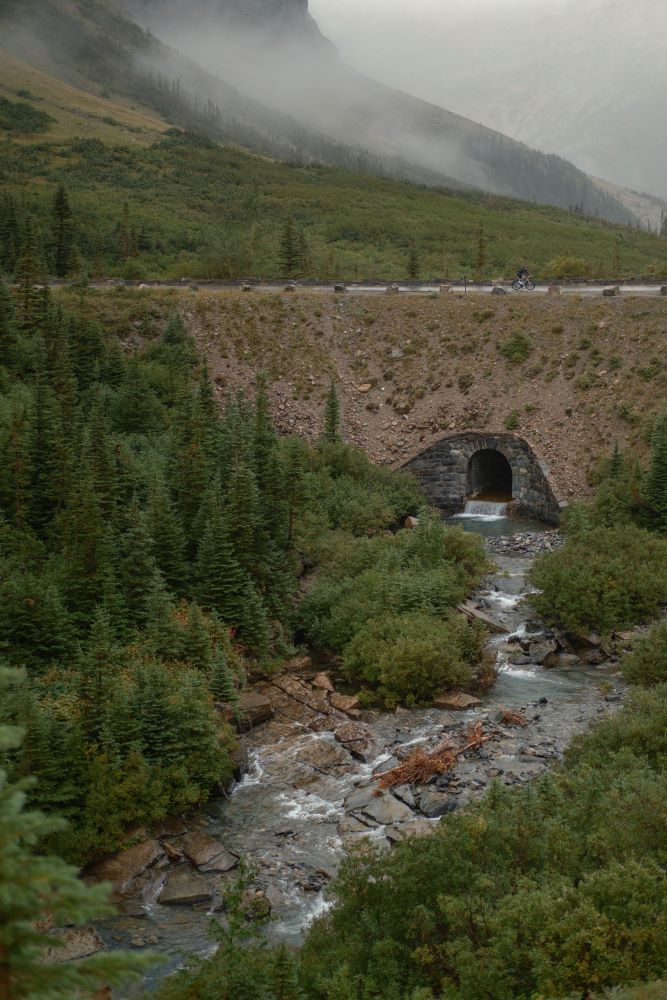
Halfway through the second cruise, an eagleeyed passenger spots a bear a few hundred metres up the side of the mountain.
It’s cool to see but, at this distance, little more than a brown speck on the hillside.
But as they say: be careful what you wish for… A few hours later, after a stunning hike to turquoise, mountain-ringed Grinnell Lake (its glassy surface and smooth stones presenting simply magical conditions for a spot of rock skipping), we’re back at the Many Glacier Hotel to do what we came here for: ride bikes.
Within minutes of rolling out, I notice a dark shadow moving across the road a few hundred metres ahead.
We keep rolling and soon get a glimpse of what is unmistakably a black bear peering directly at us from behind a bush, little more than two metres off the side of the road.
That’s close enough for me – we lock eyes, and I hit Greipel-level peak power to put a gap between me and our cuddly friend.
After the excitement of the bear sighting, the rain sets in, and we slightly regret our choice of riding the 5km of gravel road between Many Glacier and the park entrance.

I make a mental note to buy our guides a beer for the extra work they’ll have to do tonight to get the grit out of our drivetrains.
Back on the sealed stuff, we soon turn left onto Chief Mountain Highway, and pedal through the isolated town of Babb, before my phone pings to tell me we’ve arrived in Canada: it seems we’re so far north that we’ve connected to a mobile (or should I say ‘cell’) tower across the border.
I’ve never been to Canada before – can I add it to my passport now? The ride’s main challenge is Chief Mountain, which is known to the local people as Ninaistako.
As explained to us by Darnell and Smokey, two members of the Blackfeet Nation who graciously shared their people’s history and knowledge with our group the night before, Ninaistako is a sacred site for the area’s Native American community.
Rising more than 1,500 metres above the plains to reach a total height of 2,769 metres, it’s easy to sense the mountain’s significance, and we pedal up around eight kilometres of it to reach the turnaround point of the day.
After adding another layer, we descend its slopes and chop off with our guide Kyle all the way back to Saint Mary, and end the day with soggy shoes and a sense of accomplishment after doing battle with the weather and enjoying a great bike ride in the process.
Going-to-the-‘Sun’
It’s a little soggy again on the morning of the third day, but with one of America’s most scenic roads on the agenda, nothing can dampen our spirits.
Our hotel’s address is literally No.3 Going-to-the-Sun Road, and after less than a kilometre of pedalling we’re inside the park.
Evidently today’s ride is all killer, no filler.
Thick bands of cloud cling to the edge of the range, but as we make our way along the shores of Saint Mary Lake and onto the lower slopes of Logan Pass, the wind picks up enough to give us glimpses of the upper peaks between squalls.
The highest point of Going-to-the-Sun Road, Logan Pass, is also significant for crossing the Continental Divide – which separates the Atlantic and Pacific watersheds of North America – and this morning we are treated to a real-life demonstration of the mountain’s evident talent for water dispersal, the hillsides coming to life with fast-flowing streams and waterfalls.
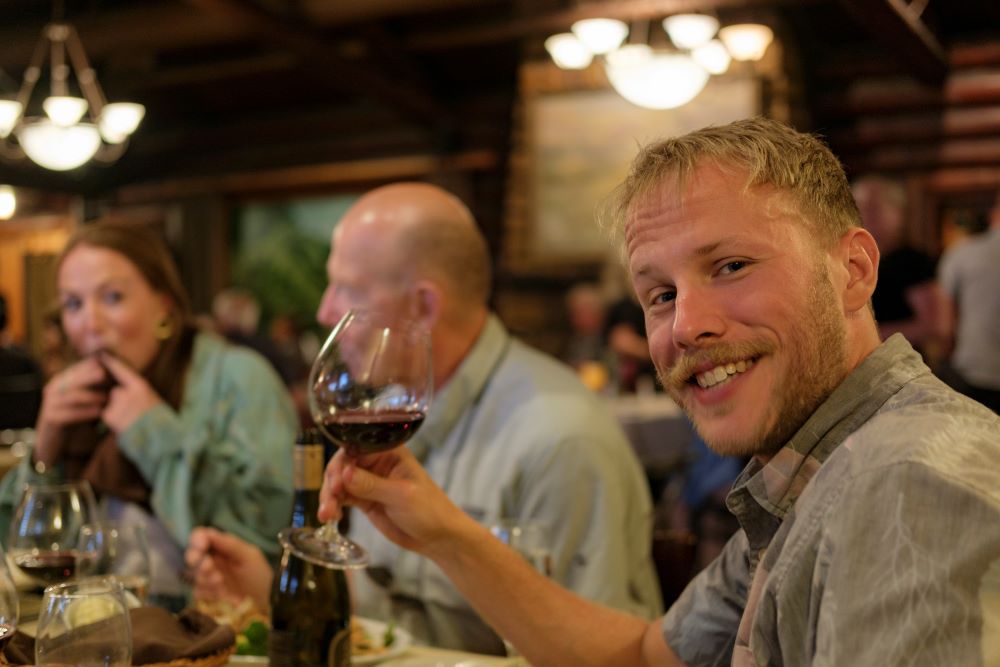
It’s a wet but exhilarating experience to be out there in the elements, and we enjoy an epic ascent of the eastern and lesser-known side of the climb with only a handful of road trippers for company.
We descend into a void of white cloud on the other side of the pass (height: 2,026 metres), and once the road levels out for good around 17km later, we turn around and psych ourselves up for the ascent.
It’s a lot more fun going up than down in this weather, and conditions remain ‘epic’ as we make our way up the steady gradients and gentle bends to the top of the climb, a feat that takes about an hour at a fairly steady clip.
Both sides now completed, it has been an unforgettable ride, but it’s certainly a relief to hear there will be more time to enjoy this road and its world-famous views – of which we only caught glimpses – at a later point in the trip.
Lakeside tranquillity
When I’d been sent the itinerary a few weeks before, day four wasn’t the one that jumped out at me, but it turns out to be a bit of an unexpected highlight – all thanks to some extras tacked on at the end of the official route, my longest ride of the trip.
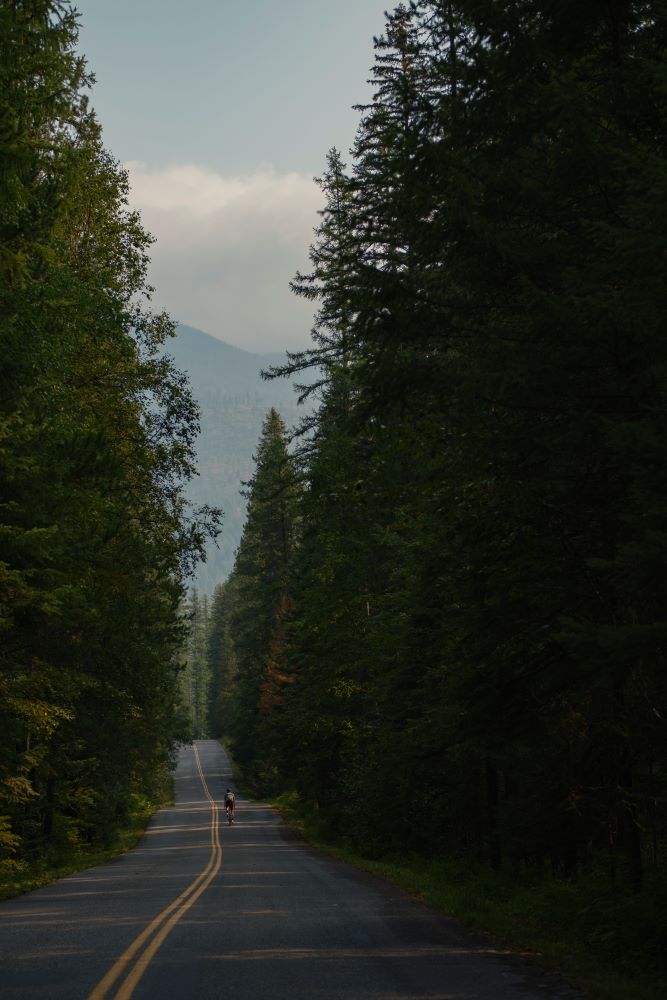
Starting in Whitefish (which we’d returned to the previous afternoon after two nights in Saint Mary) we roll out as a group along the shores of the town’s eponymous lake, past multi-million-dollar properties and through lush pine forests, the road a rollercoaster ribbon of bliss and the precipitation of the previous two days a distant memory.
Regrouping again at the lake’s northern tip, we head back the way we came, but make a left turn before reaching town to tackle two solid climbs: the first to the ski resort of Big Mountain (7.3km at 6.6%) and the second through a well-heeled community called Iron Horse, built around an impossibly green golf course of the same name (3.6km at 6.9%).
Back in Whitefish with 60km covered, it has been a great morning of pedalling, but it’s barely midday and I’m keen for more.
After refuelling with an iced latte and a serving of avocado toast (you can take the boy out of Sydney… yada yada) I saddle up again for a solo four-hour jaunt around the flatter, more rural backroads towards Kalispell.
My Domane’s 32mm tyres make short work of the intermittent gravel sections, so it’s ironic when I end up flatting on a sealed section of the idyllic Farm to Market Road.

I completely bungle the CO2 canister reinflation and endure around 10km at 15 PSI before spotting two mountain bikers parked at the head of a local trail network.
I think my Australian accent confuses them a little, but cheers for letting me use your floor pump all the same, fellas.
Back at adequate tyre pressure, I take advantage of a cranking tailwind and enjoy a super-fast return leg to Whitefish.
Six-and-a-half hours and 171km after rolling out with the group in the morning, we arrive at one of the town’s handful of breweries and cap off a perfect day’s riding with a pint and a truly knockout hot dog.
The prime rib I consume at dinner a couple of hours later is even better – with all that pedalling, who says you can’t indulge in double dinner?
The Big Show
It’s completely clear on the morning of day five, and we depart Whitefish early, giddy with anticipation – the weather conditions are looking ideal.
Before too long we’re kitted up and back on the eastern slopes of Logan Pass, and I have my moment of riding bliss next to the lake as Esjay snaps photo after photo in the golden morning light.
While we’d had glimpses of the grandeur two days earlier, it’s incredible seeing Glacier National Park in all its glory, and I use this adrenaline to give it a solid whack up the climb, the view opening up massively at the Piegan Pass trailhead where the scenery turns fully alpine.
Despite a block headwind for the last few kilometres to the top, it’s a really enjoyable ascent, the expansive mountain views to my left distracting from the pain in lungs and legs.
Rolling over the top of the pass, we’re finally treated to a view of the more famous side of Going-to-the-Sun Road, and it’s definitely worth the wait.
To my left, beyond a small twofoot- high retaining wall, the road simply drops away into a massive U-shaped valley, a legacy of the enormous glaciers that once carved their way through this area.
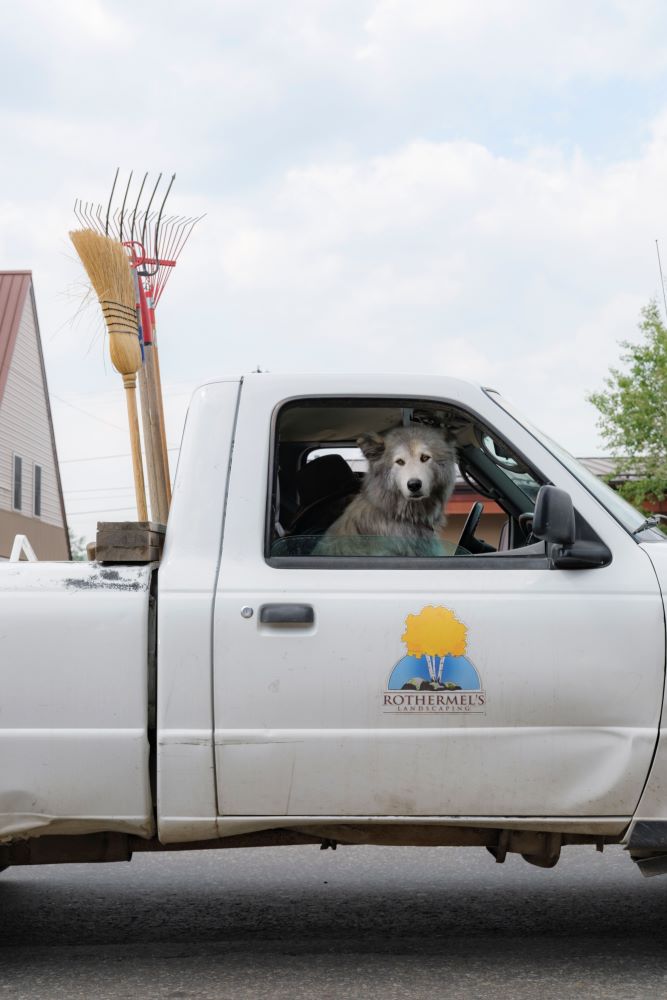
Further down the road – which clings in a remarkably straight line to the edge of the mountain, no switchbacks required – light blinks off a convoy of cars making their way up the steady gradient, just tiny multicoloured specks in the distance.
Given the change in weather, the park is a little busier today, but we still get a nice clear run down the descent, its 5-6% slope allowing for a nearly brakeless passage.
On such a picture-postcard day, it’s easy to see why the park is so popular, and I’m struggling to compare it to anywhere else I’ve been as vanloads of awestruck tourists staring wide-eyed at the view overtake me on the way back up to Logan Pass.
For such a long climb the gradient is ridiculously steady, making it very easy to find a rhythm, and while I don’t threaten the KOM of Montana-born ex-pro Levi Leipheimer, I haven’t flown to the other side of the world to ride at recovery pace either.
The combination of the effort and the dreamlike quality of the scenery makes the 56-minute ascent pass by in a flash, and after a few final happy snaps at the top, it’s time to get back in the van.

I could’ve stayed out there for hours. One last spin on the morning of day six and still pinching myself from the day before, it’s time to bid adieu to our guides and fellow riders.
I take the chance to have a chat with Kyle, who agrees with me when I wax lyrical about Going-to-the- Sun Road.
‘It’s definitely the crown jewel of this trip, and honestly, it’s one of the best rides in all of North America,’ he tells me over the hum of tyres and drivetrains.
‘People getting to experience such a beautiful, scenic, historic road and one of the best national parks that America has to offer – that’s what really sets this trip apart.’
Majestic mountains, glittering lakes, and pristine roads, both tarmac and gravel – I can see why locals call Montana the ‘Last Best Place’, and most of them aren’t even cyclists.
Add it to your bucket list.
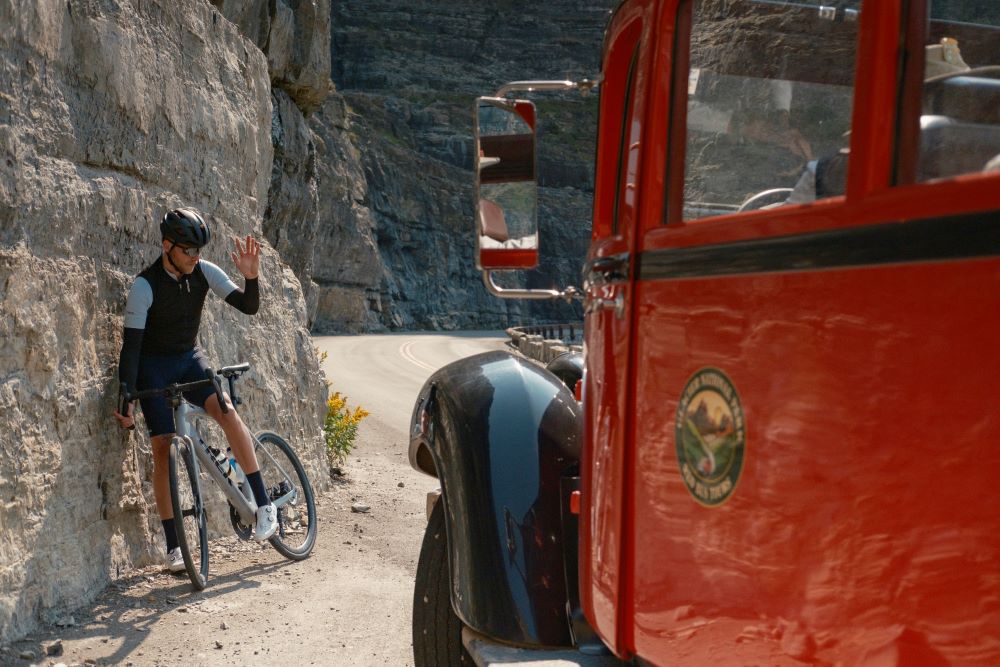
The route we took
Well, one of many routes we took to be more accurate, but definitely our favourite – here’s the Going-to-the-Sun Road

While there are a few different ways to hit Going-to-the-Sun Road, this is probably the best one in terms of pure bang for buck.
Starting in Saint Mary, jump on Going-to-the-Sun Road, which leaves town in a north-westerly direction.
Within 500 metres you’ll be inside Glacier National Park. The first 10km are pretty flat, with great views over Saint Mary Lake to your left.
At Rising Sun Campground, the road begins to rise at a gentle 1-2% for the next 10km, until the climb properly gets going just shy of the 20km mark.
The east side of Logan Pass is definitely the easier side – at 4.9% average for 11.7km – but it’s still a solid (and extremely picturesque) grind to the top.
Take the opportunity to fill your bottles at the top of Logan Pass (2,026m), then drop down the other side of the Continental Divide for a truly gobsmacking view and a lovely, smooth descent.
You can turn around wherever you like once the road flattens out around 18km later, but we suggest enjoying the hot mix and greenery until you reach the Avalanche Creek Picnic Area at kilometre 58.
Make sure to admire the remarkably clear glacial water in the river just off the edge of the road, or take a dip if it’s hot.
From here it’s an easy 12km of flat back in the same direction, before you hit the main (and harder) side of Logan Pass – one of the best climbs in North America, and if we’re judging based on looks, the world.
At 17.7km long and an average of 5.3%, it’s not a brute, but 1,121m of elevation gain is enough to leave even the hardiest of mountain goats a little sore the next day.

By the numbers
Let’s do the math (that’s right, no S)
12,000 Approximately how many years ago Native American peoples first settled in the region now called Montana – corresponding with the close of the last Ice Age.
2,026 The height in metres of Logan Pass, the highest point of Going-to-the-Sun Road and our whole trip to Glacier NP. Altitude training!
1932 The year Going-to-the-Sun Road officially opened to the public. However, infrastructure work on the road continued until 1955, when the last section was finally paved.
762 The number of lakes in Glacier NP. One of the most scenic has to be turquoise Grinnell Lake, which our group sailed and then hiked to on day two (no wheels required).
2 Bears spotted: one from the comfort and security of a boat on the aforementioned lake cruise, the other spitting distance from the road, with nothing but a bidon for protection. Exhilarating.
1 Bigger-than-your-head ‘wet’ breakfast burrito consumed – pre-ride, we might add.
Do it with Trek Travel
trektravel.com/trip/glacier-national-park-bike-tour
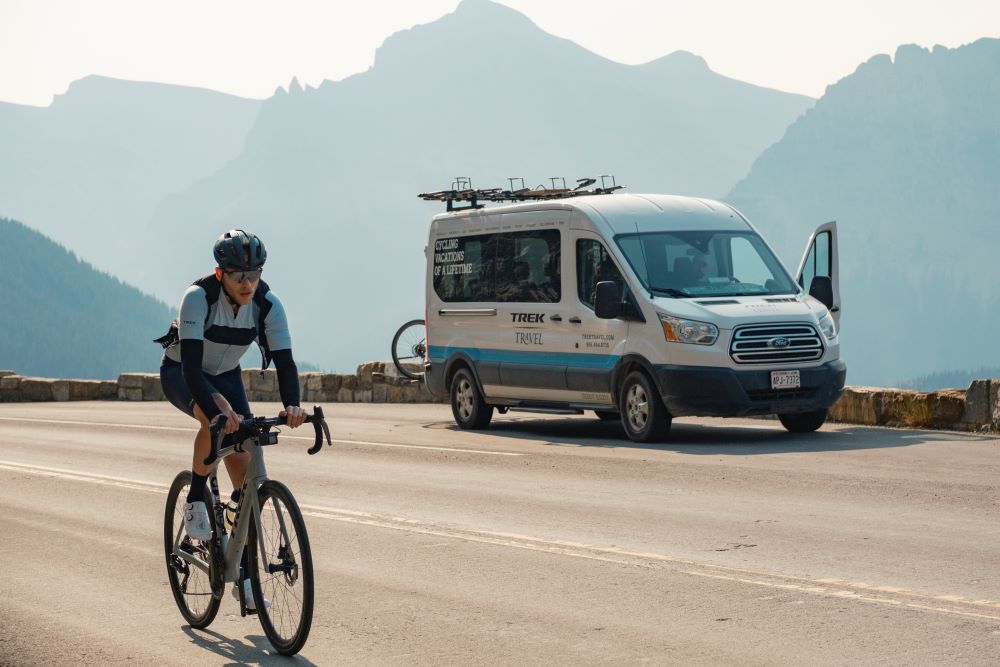
Without a tour group or private driver, getting to the start and being picked up at the end, as well as organising passes to enter Glacier NP, will be all up to you – so why not make it easy and book the premium experience with Trek Travel? However you choose to tackle it, make sure you start early – cyclists are prohibited from riding the western side of the climb after 11am.
Also, while Going-to-the-Sun Road is definitely the showstopper in the area, we also enjoyed a number of other great rides in Glacier National Park and around Whitefish.
Check out our full itinerary here: trektravel.com/trip/glacier-national-park-bike-tour/
The rider’s ride
Trek Domane SL7 Ultegra Di2, trekbikes.com/au
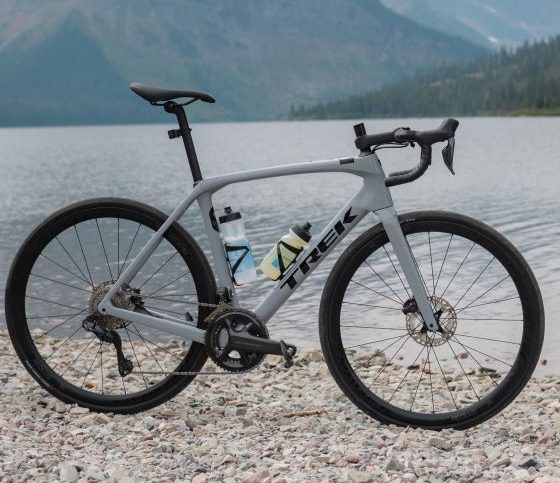
Included as part of our Trek Travel trip to Glacier was a fully dialled Trek Domane SL7.
Kitted out with Shimano’s Ultegra Di2 groupset – and a climbing-friendly 11-34 cassette – as well as Bontrager’s Aeolus Pro 37 Carbon wheelset, the endurance-focused but still ‘fast’ feeling Domane was the perfect bike for the trip.
Most of our rides were spent on smooth hot mix, but the 32mm tyres and Trek’s excellent Rear IsoSpeed Decoupler easily handled any sketchy or loose surface we encountered.
Beyond the high-end specs, our guides (and mechanics) for the trip had our Domanes set up exactly to our individual fit specifications, which we emailed through a couple of weeks before the trip.
A few tweaks on the ground and we were ready to roll… except for the fact that we forgot to ask ahead of time for an Australian/UK brake lever configuration on our rigs.
D’oh! An overnight swap by our on-ground guide/mechanic – not an easy or quick job – had us rolling with right-front, left-rear the morning of day two. The Trek Travel team really does go above and beyond.
Thanks guys.
How we did it
TRAVEL
Getting to Glacier National Park from Australia is easier than you might think.
From Sydney, we flew with United to LAX, before transferring a few hours later onto a direct flight (just under three hours in duration) to Glacier Park International Airport, located on the outskirts of Kalispell, Montana.
From the airport it was an easy 20-minute shuttle to the Firebrand Hotel in downtown Whitefish.
Making the whole exercise easier was the fact we didn’t have to fly with our bike bags – our Trek Domanes were waiting for us in Montana.
ACCOMMODATION
In Whitefish, we stayed at the Firebrand (firebrandhotel.com), centrally located and with all the amenities you’d expect from a 4-star hotel.
The beds and pillows were super comfy, the water pressure was firm, and the staff were helpful and friendly.
The rooftop was also a great place to catch the sunset, beer in hand and with a firepit to keep things toasty once the sun went down.
The first two nights of the tour were spent at the spacious Saint Mary Village (glacierparkcollection.com/lodging/st-mary-village) in the remote, tiny tourist town of the same name, a perfect base for exploring the grandeur of Glacier.
FOOD
Where to begin? When you travel to the US, you know you’re going to leave with a full stomach.
Highlights included the surprisingly authentic tacos at the Whitefish VFW (the US equivalent of an RSL club), the prime rib at the Whitefish Lake Golf Club (top-three steaks of my life), the hot dog at Bonsai Brewing Project, and the ‘wet’ breakfast burrito and bison quesadillas at the Snow goose in Saint Mary.
For an authentic American diner experience, Buffalo Cafe in Whitefish was also great; and for an Australian-level flat white (yes, they have them in the States now), Wild Coffee Company is your best bet
THANKS
The biggest thanks goes to Trek Travel (trektravel.com) for having us along on a truly once-in-a-lifetime trip – Montana wasn’t on my riding radar, but it certainly is now!
From the team at head office who made sure everything was seamless in the lead-up, to our team of expert guides on the ground (Eric and Kyle, two absolute legends) it was all perfect.
Thanks also to our fellow travellers on the trip, for enduring Esjay’s and my never-ending conversation and sometimes-confusing Australian vernacular – it was great to meet ‘y’all’. Another shout-out to the team at Trek here in Australia, who kitted us out from head-to-toe.
In particular, the recently released Velocis helmet is a cracker: lightweight, comfortable and stylish, we can see why Lidl- Trek are using it as their non-aero option this season.
We also loved the Velocis bib shorts, which feature a premium, breathable chamois and low-profile straps, perfect for those days in the mountain sun.

